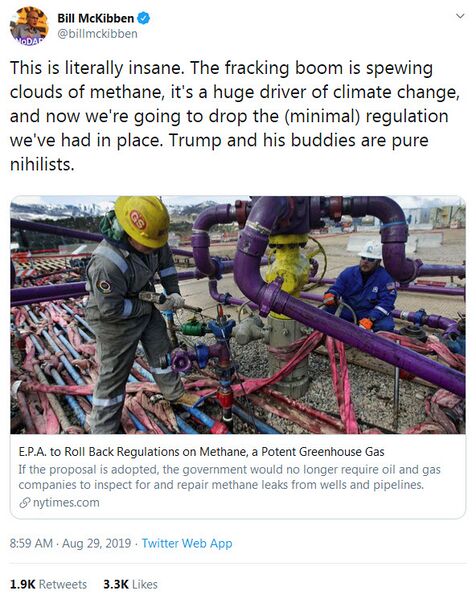File:US EPA to reverse methane rules.jpg

Original file (592 × 745 pixels, file size: 175 KB, MIME type: image/jpeg)
Bill McKibben / 350.org / https://twitter.com/billmckibben/status/1167059264462086144
Via the NY Times / E.P.A. to Roll Back Regulations on Methane, a Potent Greenhouse Gas
Aug. 29, 2019
The Trump administration laid out on Thursday a far-reaching plan to cut back on the regulation of methane emissions, a major contributor to climate change.
The Environmental Protection Agency, in its proposed rule, aims to eliminate federal requirements that oil and gas companies install technology to detect and fix methane leaks from wells, pipelines and storage facilities. It will also reopen the question of whether the E.P.A. even has the legal authority to regulate methane as a pollutant.
The rollback is particularly notable because major energy companies have, in fact, spoken out against it — joining the ranks of automakers, electric utilities and other industrial giants that have opposed other administration initiatives to dismantle climate-change and environmental rules. Several of the world’s largest auto companies are pushing back against President Trump’s plans to let vehicles pollute more, saying those rollbacks stand to split the United States auto market in two, and utilities have opposed the relaxation of restrictions on toxic mercury pollution from coal-burning power plants...
Anne Idsal, the agency’s acting senior clean-air official, said the Obama-era rules being eliminated have “minimal environmental benefits.”
Environmental advocates described the proposal as a major setback in the effort to fight climate change. Methane is a potent greenhouse gas.
“The Trump E.P.A. is eager to give the oil and gas industry a free pass to keep leaking enormous amounts of climate pollution into the air,” said David Doniger, a lawyer with the Natural Resources Defense Council, an advocacy group. “If E.P.A. moves forward with this reckless and sinister proposal, we will see them in court.”
Fox News
According to The Wall Street Journal, the plan would also stop legal requirements that force the EPA to set rules on emissions from pre-existing well and industry sites.
“The purpose of this rule is to get to the fundamental basis of whether [methane] should have been regulated in the first place,” Anne Idsal, the acting assistant administrator for the Environmental Protection Agency’s Office of Air and Radiation, told the Journal. “It’s not about whether we’re doing the maximum we can or should do to deal with” climate change.
Report from New Mexico, a center of fracking and gas/oil-methane production in the US
“The biggest problem with the whole debate is that the numbers are unknowable,” David Dixon, economics lecturer at UNM, told NM Political Report. Dixon prepared an economic impact analysis for increased regulations around methane production back in 2007, when then-Governor Bill Richardson proposed reducing methane emissions by 20 percent.
“Neither the state of New Mexico nor the EPA monitors gas coming out of the ground,” Dixon said. Gas producers report on the amount of gas that is delivered to processing plants downstream, he said, which determines the amount of royalties paid to the state.
“Fugitive methane—whether from a leaky well, leaky equipment or pipelines, or bad practices—can only be estimated,” he added. “Gas producers in general, and independent gas producers in particular, resist well-head gas monitoring so vigorously that no one has ever had the political will to even suggest it.”
EPA’s numbers are off
Study after study has shown the EPA is grossly underestimating methane emissions. There were three studies released this summer alone indicating the agency’s methane accounting was not accurate.
Read More at NM Political Report
○
File history
Click on a date/time to view the file as it appeared at that time.
| Date/Time | Thumbnail | Dimensions | User | Comment | |
|---|---|---|---|---|---|
| current | 18:52, 29 August 2019 |  | 592 × 745 (175 KB) | Siterunner (talk | contribs) |
You cannot overwrite this file.
File usage
The following page uses this file:
- Air Quality
- Air Pollution
- Agriculture
- Alternative Agriculture
- Antarctica
- Anthropocene
- Arctic
- Atmospheric Science
- Climate Change
- Climate Migration
- Climate Policy
- Desertification
- Digital Citizen
- Earth Imaging
- Earth Observations
- Earth360
- Earth Science
- Earth Science from Space
- Earth System Science
- Ecology Studies
- Eco-nomics
- Education
- Energy
- Environmental Laws
- Environmental Protection
- Environmental Security
- Environmental Security, National Security
- ESA
- European Union
- Externalities
- Extinction
- Florida
- Food
- Forests
- Fossil Fuels
- Greenland
- Global Security
- Global Warming
- Green Networking
- Green Politics
- Health
- INDC
- Maps
- Money in Politics
- NASA
- NOAA
- Natural Resources
- Networking
- New Definitions of National Security
- New Economy
- New Space
- Oceans
- Ocean Science
- Planet Citizen
- Planet Citizens
- Planet Citizens, Planet Scientists
- Rainforest
- Renewable Energy
- Resilience
- Sea-level Rise
- Sea-Level Rise & Mitigation
- Soil
- Solar Energy
- Strategic Demands
- Sustainability Policies
- Threat Multiplier
- United Nations
- US
- US Environmental Protection Agency
- Water Quality
- Whole Earth
- Wind Energy
- World Bank
- World Wide Web
- Youth